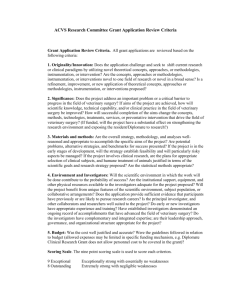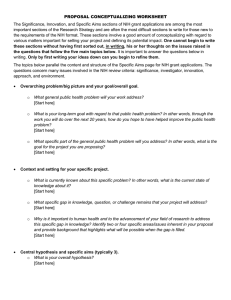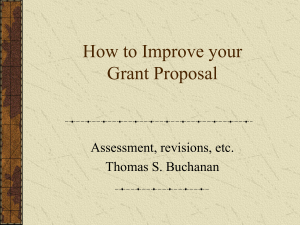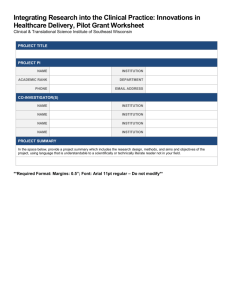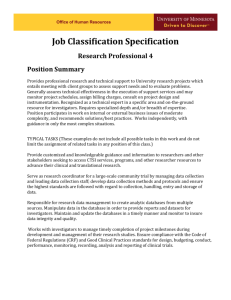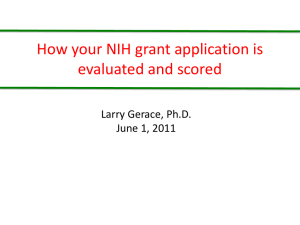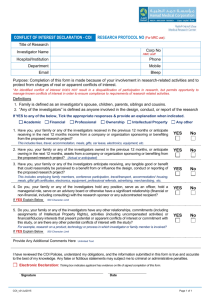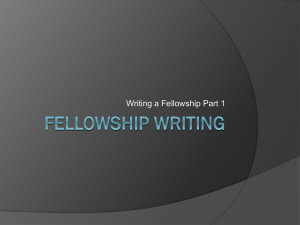Full Proposal Guidance - Canyon Ranch Center for Prevention and
advertisement
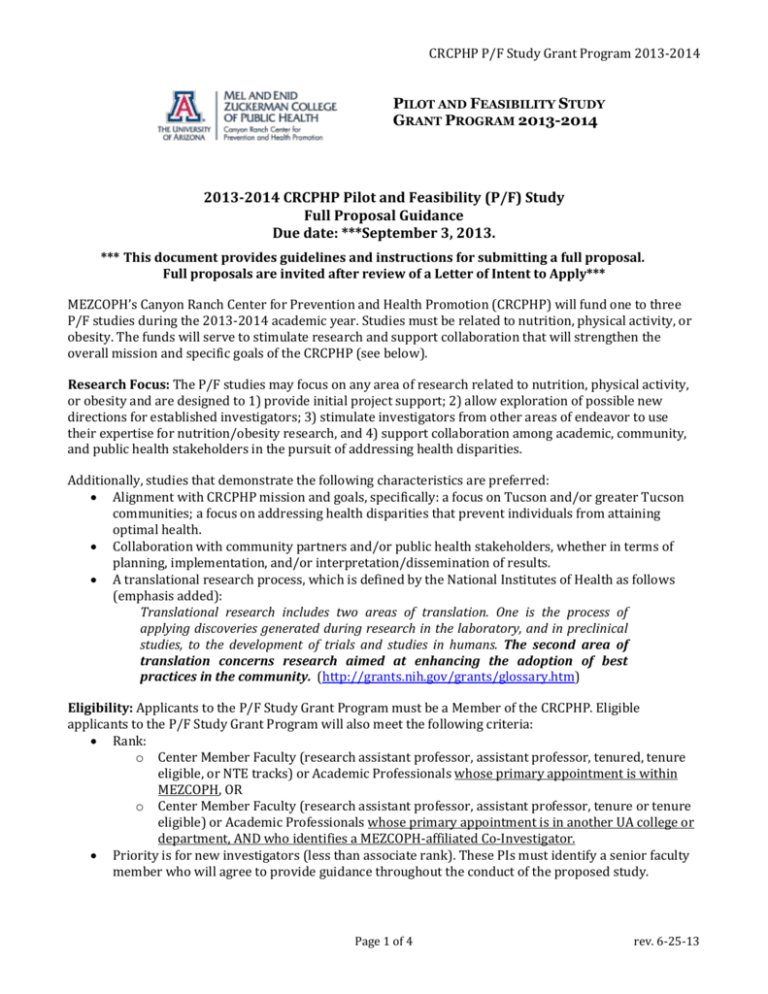
CRCPHP P/F Study Grant Program 2013-2014 PILOT AND FEASIBILITY STUDY GRANT PROGRAM 2013-2014 2013-2014 CRCPHP Pilot and Feasibility (P/F) Study Full Proposal Guidance Due date: ***September 3, 2013. *** This document provides guidelines and instructions for submitting a full proposal. Full proposals are invited after review of a Letter of Intent to Apply*** MEZCOPH’s Canyon Ranch Center for Prevention and Health Promotion (CRCPHP) will fund one to three P/F studies during the 2013-2014 academic year. Studies must be related to nutrition, physical activity, or obesity. The funds will serve to stimulate research and support collaboration that will strengthen the overall mission and specific goals of the CRCPHP (see below). Research Focus: The P/F studies may focus on any area of research related to nutrition, physical activity, or obesity and are designed to 1) provide initial project support; 2) allow exploration of possible new directions for established investigators; 3) stimulate investigators from other areas of endeavor to use their expertise for nutrition/obesity research, and 4) support collaboration among academic, community, and public health stakeholders in the pursuit of addressing health disparities. Additionally, studies that demonstrate the following characteristics are preferred: Alignment with CRCPHP mission and goals, specifically: a focus on Tucson and/or greater Tucson communities; a focus on addressing health disparities that prevent individuals from attaining optimal health. Collaboration with community partners and/or public health stakeholders, whether in terms of planning, implementation, and/or interpretation/dissemination of results. A translational research process, which is defined by the National Institutes of Health as follows (emphasis added): Translational research includes two areas of translation. One is the process of applying discoveries generated during research in the laboratory, and in preclinical studies, to the development of trials and studies in humans. The second area of translation concerns research aimed at enhancing the adoption of best practices in the community. (http://grants.nih.gov/grants/glossary.htm) Eligibility: Applicants to the P/F Study Grant Program must be a Member of the CRCPHP. Eligible applicants to the P/F Study Grant Program will also meet the following criteria: Rank: o Center Member Faculty (research assistant professor, assistant professor, tenured, tenure eligible, or NTE tracks) or Academic Professionals whose primary appointment is within MEZCOPH, OR o Center Member Faculty (research assistant professor, assistant professor, tenure or tenure eligible) or Academic Professionals whose primary appointment is in another UA college or department, AND who identifies a MEZCOPH-affiliated Co-Investigator. Priority is for new investigators (less than associate rank). These PIs must identify a senior faculty member who will agree to provide guidance throughout the conduct of the proposed study. Page 1 of 4 rev. 6-25-13 CRCPHP P/F Study Grant Program 2013-2014 Funding Level and Period: Studies will be funded up to $30,000 for a 12-month grant period. The actual amount of funding available per grantee will be based the number of competitive proposals and will range from $15,000 to $30,000. *** Budget Restrictions: An individual can receive no more than 15% in salary support. There are no other budget restrictions other than the usual UA policies. Budgetary oversight will be provided through the COPH Business Office. Deliverables: Acceptance of funding will indicate agreement to present study findings at a professional/research conference, and to submit of a grant for extramural funding. Progress reports will be due at Month 6, and a final report will be due within 30 days of the end of the 12-month grant period. Procedure: Full proposals are invited after review of a Letter of Intent to Apply. Please send all proposal materials electronically to Jennifer Peters (petersjs@email.arizona.edu). Step One: Letter of Intent & Supporting Documents. Due date: July 23, 2013. *** Step Two: Full Proposal. Due date: September 3, 2013. By August 9, 2013, invitations to submit a full proposal will be sent. The full proposal format (modified from NIH R03/R21 format) is as follows: *** Font must be Arial, Helvetica, Times, or Georgia, 11 points or larger, and black. Symbol fonts may be used to insert Greek letters or other special characters, but the font size requirement still applies. Smaller type may be used for figures, graphs, diagrams, charts, tables, figure legends, and footnotes: but it must be legible and all text must be in black. Colors can be used in figures. Paper must be standard size (8.5 x 11 inches), with margins of at least one-half inch on all sides. Please insert Page Numbers. *** It will be very helpful if you can submit your proposal as one combined PDF document. If you need help with this, please ask Jennifer Peters. 1. Project Summary/Abstract (30 lines) a. The project summary is intended as a summary of the proposed activity suitable for public presentation or dissemination. It should contain a statement of objectives and methods to be employed, and should be written so as to be informative to other persons working in the same or related fields and, insofar as possible, to a scientifically literate lay reader. Do not include any proprietary or confidential information in the project summary, as it will be available for public viewing. This section is meant to serve as a succinct and accurate description of the proposed work, when separated from the application. This section cannot be longer than 30 lines of text. 2. Bibliography/References Cited a. Provide a bibliography of any and all references cited in the research strategy. Each reference must include the names of all authors (in the same order in which they appear on the publication), the article and journal title, book title, volume number, page numbers (both starting and ending), and year of publication. Include only bibliographic citations. 3. Biosketch a. Use the sample format provided by NIH. Biographical sketches must be included for all Senior/Key personnel and other significant contributors. Biographical sketches may not ordinarily exceed four pages per person, including the table at the top of the first page in the sample. Page 2 of 4 rev. 6-25-13 CRCPHP P/F Study Grant Program 2013-2014 4. Specific Aims – Limited to 1 page. a. List succinctly the broad, long-term objectives and the goal of the proposed research. For example, to test a stated hypothesis, create a novel design, solve a specific problem, challenge an existing paradigm or clinical practice, address a critical barrier to progress in the field, or develop new technology. This section is limited to one page. 5. Research Strategy – Limited to 6 pages. a. Significance. Briefly sketch why this proposed research is significant. Identify gaps in current knowledge or practice that the project intends to fill. State concisely the importance and health relevance of the proposed research by relating the specific aims to the broad, long-term objectives. b. Innovation. Does this proposed research challenge and seek to shift current research or clinical practice paradigms by using novel theoretical concepts, approaches, methodologies, instrumentation, or interventions? c. Approach. Describe the research design (briefly!), and the conceptual or clinical framework, procedures, and analyses to be used to accomplish the project’s specific aims. Unless specified elsewhere, indicate how the data will be collected, analyzed, and interpreted, and any data-sharing plans, as appropriate. Describe any new methodology and its advantage(s) over existing techniques and practices. Discuss the potential difficulties and limitations of the proposed procedures, and alternative approaches to circumvent such limitations where feasible. Provide a tentative sequence or timetable for the project. d. Potential Impact of the Study. *** Scoring: Propoals will be peer reviewed by a cross-division committee that includes representatives from faculty, AP, and community advisors. Prior to committee review, there will be a screening of proposals to ensure that they address the goals of the CRCPHP. The scoring system and criteria follow NIH procedure and are as follows: The NIH scoring system uses a 9-point scale. We expect scores of 1 and 9 to be used less frequently than other scores. A score of 1 indicates an exceptionally strong application with essentially no weaknesses. A score of 9 indicates an application with strong and substantive weaknesses and very few strengths. This scale is used by all eligible Scoring committee members to provide an Overall Impact score, and for assigned reviewers to score five individual criteria: Significance, Investigator, Innovation, Approach, Environment. For the impact score, strengths and weaknesses across all criteria should be considered. o For each criterion rating, the strengths and weaknesses within that review criterion should be considered. Reviewers should consider not only the relative number of strengths and weaknesses noted, but also the importance of these strengths and weaknesses to the criteria and to the overall impact. For example, a major strength may outweigh many minor and correctable weaknesses. Definitions of Criteria: 1. Significance. Does the project address an important problem or a critical barrier to progress in the field? If the aims of the project are achieved, how will scientific knowledge, technical capability, and/or clinical practice be improved? How will successful completion of the aims change the concepts, methods, technologies, treatments, services, or preventative interventions that drive this field? 2. Investigator(s). Are the PD/PIs, collaborators, and other researchers well suited to the project? If Early Stage Investigators or New Investigators, or in the early stages of independent careers, do Page 3 of 4 rev. 6-25-13 CRCPHP P/F Study Grant Program 2013-2014 they have appropriate experience and training? If established, have they demonstrated an ongoing record of accomplishments that have advanced their field(s)? If the project is collaborative or multiPD/PI, do the investigators have complementary and integrated expertise; are their leadership approach, governance and organizational structure appropriate for the project? 3. Innovation. Does the application challenge and seek to shift current research or clinical practice paradigms by utilizing novel theoretical concepts, approaches or methodologies, instrumentation, or interventions? Are the concepts, approaches or methodologies, instrumentation, or interventions novel to one field of research or novel in a broad sense? Is a refinement, improvement, or new application of theoretical concepts, approaches or methodologies, instrumentation, or interventions proposed? 4. Approach. Are the overall strategy, methodology, and analyses well-reasoned and appropriate to accomplish the specific aims of the project? Are potential problems, alternative strategies, and benchmarks for success presented? If the project is in the early stages of development, will the strategy establish feasibility and will particularly risky aspects be managed? If the project involves clinical research, are the plans for 1) protection of human subjects from research risks, and 2) inclusion of minorities and members of both sexes/genders, as well as the inclusion of children, justified in terms of the scientific goals and research strategy proposed? 5. Environment. Will the scientific environment in which the work will be done contribute to the probability of success? Are the institutional support, equipment and other physical resources available to the investigators adequate for the project proposed? Will the project benefit from unique features of the scientific environment, subject populations, or collaborative arrangements? *** Please note that while a protocol for protections of human subjects is not required to make an award, the study cannot begin until approval is received from the UA IRB. Questions: Please direct questions to Cyndi Thomson (cthomson@email.arizona.edu) or Jennifer Peters (petersjs@email.arizona.edu). Page 4 of 4 rev. 6-25-13
